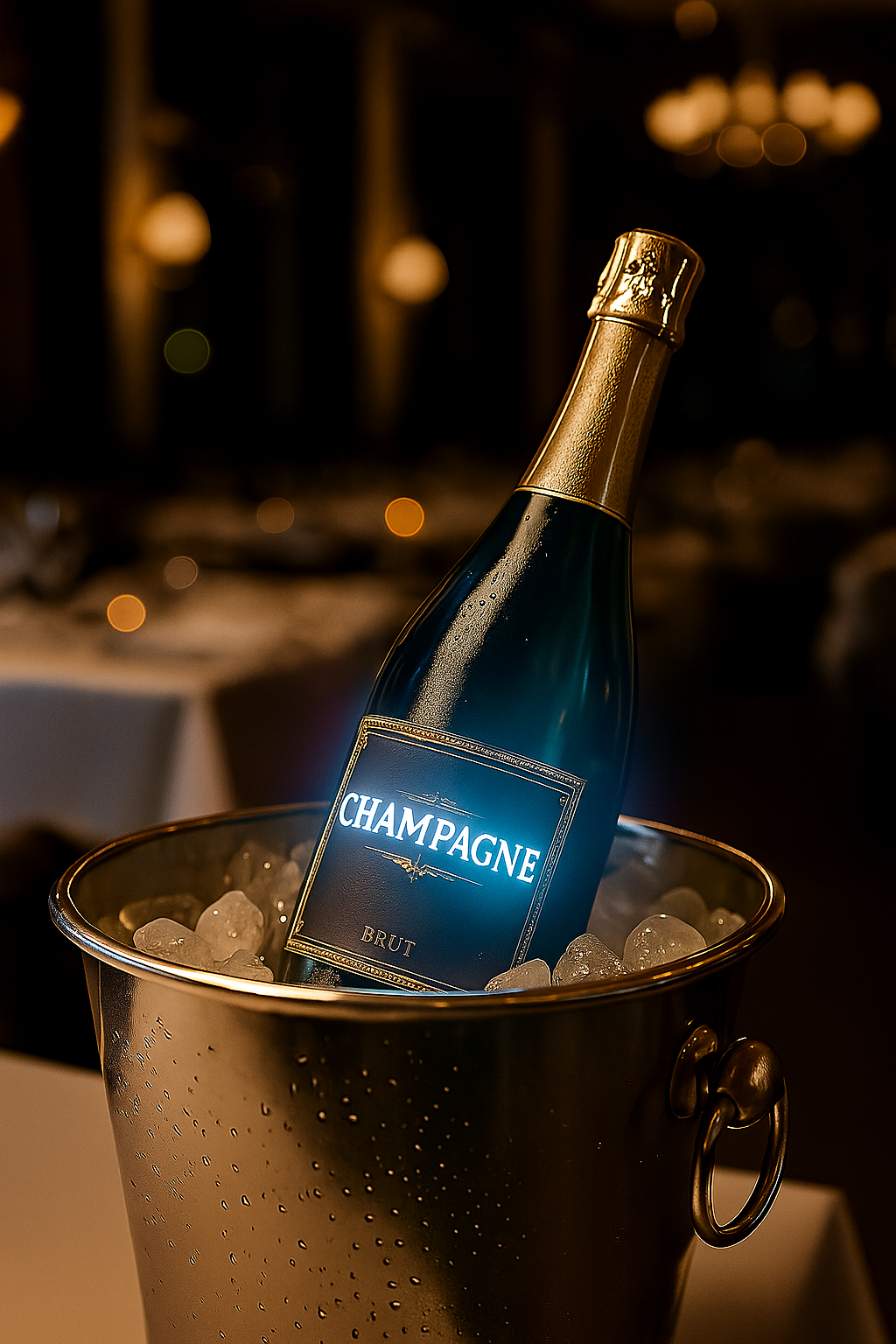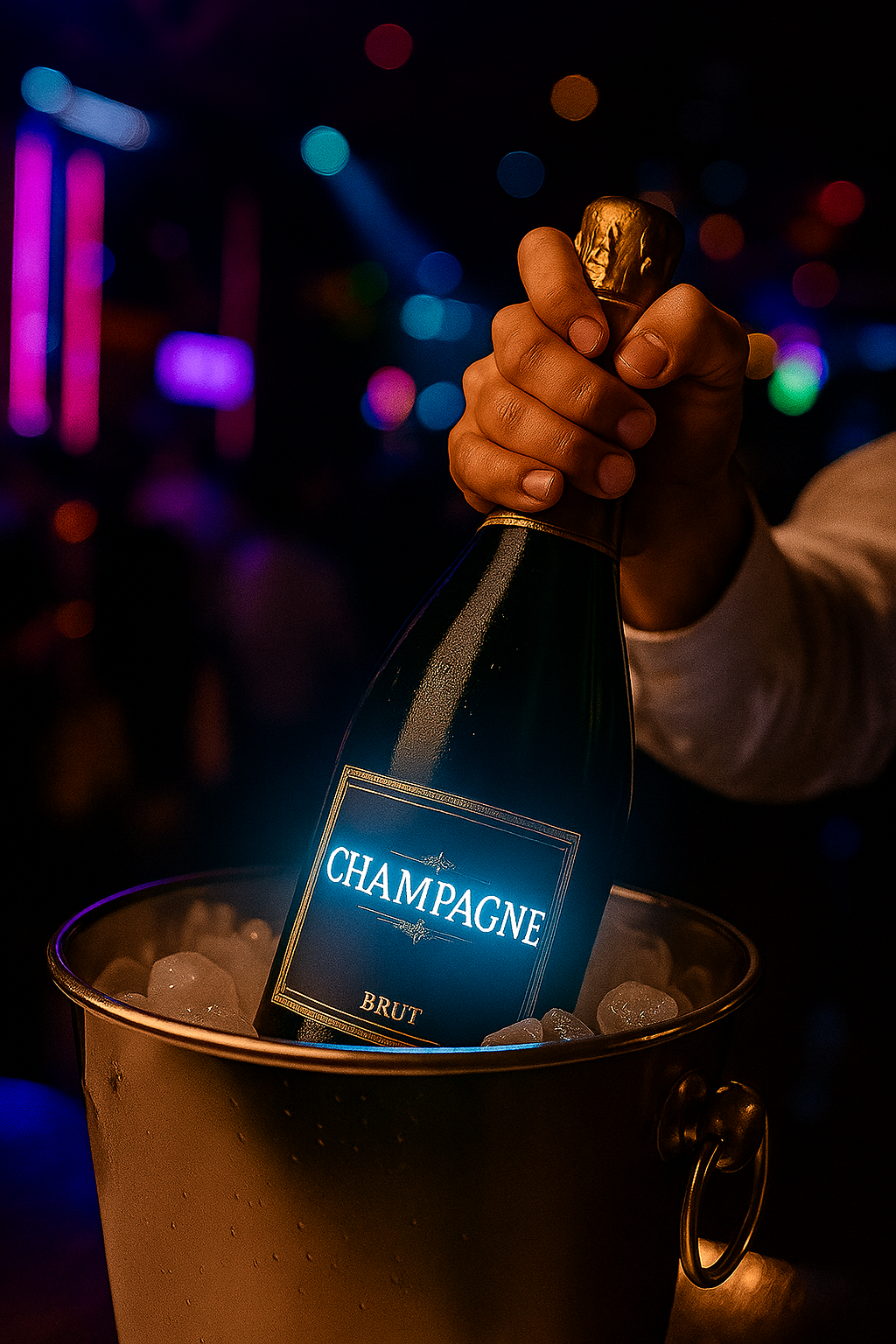An ice-bucket-proof label is a beverage label that stays flat, legible, and firmly adhered for 24–48 hours in a 50/50 ice-water bath, resisting edge-lift, wrinkling, ink or adhesive failure, and wet-paper greying.
In the wine & spirits world (and in premium nightlife service), bottles—especially whites, champagnes, sparklings, and many craft spirits—are served on ice. The accepted way to validate a label for that context is the ice-bucket test: immerse a correctly applied bottle in an ice/water bath for a defined time and visually inspect for failures. Different producers set different thresholds (1–12+ hours in many handbooks), but the working expectation for on-premise is that a premium label should remain intact and attractive through the full service occasion.

Common failure modes if a label isn’t ice-bucket-ready
Nightlife is dim, crowded, and fast-moving. Labels do a lot of work in a few seconds: help staff spot SKUs, photograph well for social, and keep a bottle looking premium from the first pour to the last. If a label greys out, wrinkles, or slides in ice, it doesn’t just look tired—recognition drops and guests order something else. Because chilled service is the default for many categories, ice-bucket survivability is table-stakes for brand protection and on-premise sell-through. Trade guides explicitly position the ice bucket test as the go-to realism check for these environments.

Cold glass sits below the dew point; moisture condenses continuously. Papers absorb water and swell unless they’re wet-strength treated or filmic. Adhesives must wet out a cold, often damp substrate and keep holding under thermal cycling. Designs with embossing, foils, and thick varnishes need barrier strategies to keep their look under saturation. Suppliers solve this with wet-strength papers, opaque barrier systems (that prevent greying), and PSAs formulated to grab cold/wet glass. Example: specialized products from Avery Dennison, UPM Raflatac, and HERMA are explicitly validated for ice-bucket duty.
There is no universal international standard that dictates one exact ice-bucket procedure for all labels. Instead, brands specify their own pass/fail (often 24–48 hours) and pair that with laboratory metrics for the underlying adhesive/laminate:
A good example of application-specific validation: Avery Dennison’s cold-wet glass adhesive Z2010 demonstrates no floating or lift for 8+ hours under immersion (and is used as a baseline for “cold & wet” bonding discussions).
Face materials.
Wet-strength papers (engineered to maintain integrity when saturated) and barrier/opaque papers combat greying; filmic faces (PP/PET) avoid water uptake entirely. Choice depends on the brand’s tactile goals vs functional risk.
Adhesives.
Select a cold-wet glass PSA—validated on chilled, humid bottles—and check the supplier’s data across peel, tack, and shear. If you apply to condensing bottles, prioritize chemistries and coatweights designed for “wet out” on low-energy, cold surfaces; generic “room-temp general purpose” PSAs won’t do.
Print & finishing stack.
Choose inks, foils, and varnishes that have water resistance ratings compatible with extended immersion. Where you need heavy emboss or foils, reserve a “grain-/emboss-free zone” at edges to support adhesion—another common handbook recommendation.
Application process.
Whatever the material, application quality decides the outcome. Bottles must be clean and residue-free; application pressure and alignment need to be correct; and on automated lines, nip pressure and sensor flags should be tuned so no machine parts scuff key design windows. (Formal validation then couples lab metrics with the bucket test.)
If your label includes light, the optical behavior matters as much as water resistance:
From a reliability perspective, OLED semiconductors are sensitive to moisture, so proper encapsulation/barriers are essential. When the device is well-sealed inside the label laminate, you can combine the best of both worlds: uniform, low-glare glow plus robust ice-bucket performance. For a primer on how light-up bottles work and how triggers are integrated, see our guide.
The points below summarize our internal R&D and QA practice. They complement—rather than replace—industry standards cited above.
Our qualification matrix for printed-OLED beverage labels includes: visual/appearance & dimensional checks; tape test; incoming quality control; UV exposure; POSM handling; spray cocktail & immersion cocktail tests; thermal shock/cyclic aging; brightness/optical measurements; heat/humidity (multiple aging); finished-product checks; POSM pouring/use tests; weight; chilled & hot-humid storage; finished bottle inspections; and, of course, the ice-bucket test.
Is there a single standard everyone uses?
No. Brands specify their own pass/fail windows and confirm with supplier data (FINAT/ASTM for adhesive strength; ice-bucket for real-world behavior). Handbooks in wine & spirits describe the method (often 50/50 ice/water), but duration varies by brand.
How long should a premium label last in an ice bucket?
For on-premise, 24–48 hours is a common benchmark; some adhesives/constructs publish longer validations, and internal programs may push further to build margin.
Do filmic labels solve everything?
Films avoid water uptake and stay bright, but papers can match the look/feel many wine brands want—wet-strength + barrier papers defend against greying and wrinkles while keeping that tactile premium feel.
If OLEDs are moisture-sensitive, can a light-up label really survive in ice?
Yes—with proper encapsulation and laminate sealing. The device is sensitive, but the label construction protects it. That’s how we pass real immersion tests while delivering uniform light.
An ice-bucket-proof label is not an optional nicety for chilled service; it’s the baseline for brand protection in bars, clubs, lounges, and VIP venues. Combine materials designed for cold/wet glass, disciplined application, and clear pass/fail criteria, and you’ll get labels that look premium for the entire service window—even when they glow.
Need help specifying or validating your next on-ice label? Let’s design a nightlife-ready, ice-bucket-proof label together—reach out to Inuru.
SOURCES:
(1)https://label.averydennison.com/eu/en/home/products/wine-labels/the-ice-bucket-challenge.html
(2)https://www.herma.com/material/products/paper-based-label-materials/wine-materials/
(3)https://www.inuru.com/post/how-do-light-up-bottles-in-bars-actually-work
(4)https://www.inuru.com/post/oled
(5)https://www.labelmaterials.upm.com/labels-by-industry/wine-spirits-and-craft-beverage-labels/
(7)https://www.energy.gov/eere/ssl/oled-basics
(8)https://store.astm.org/d3330_d3330m-04r18.html
(9)https://www.finat.com/documents/540/technical-handbook-2019-folder-low.pdf